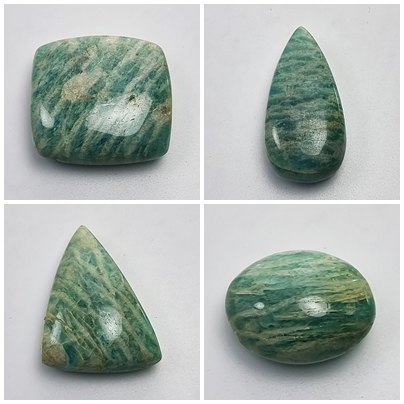Amazonite: Gemstone Information

“Discover serenity with Amazonite – the tranquil gemstone that soothes the soul with its calming blue-green hues.”
The name amazonite appears to have evolved from the term ‘Amazon stone’ which, perhaps through confusion, was applied originally to another green mineral from that region as amazonite is not found anywhere in the Amazon basin.
Synonyms: Amazon stone; amazon stone; mother of emerald; green feldspar; microcline, Colorado Jade, and Amazon Jade. Amazonite is an opaque to translucent, blue to green, variety of microcline characterized by streaks of white exsolved albite. The color has been attributed to three variables: lead, structural water and natural radiation.
Hoffmeister and Rossman (1985) proposed that while lead does indeed play a role in coloring amazonite, both natural radiation and structural water are necessary to produce chromophoric monovalent or trivalent lead. The natural decay of potassium40 reduces Pb2+ to Pb1+, produces hydroxyl radicals that oxidize nearby oxygens to form hole center and oxidizes Pb2+ to Pb3+. Comparison of color intensity with Pb concentration indicated no correlation.
It has been suggested that if there is a higher degree of Al/Si disorder then green is the dominant color. Heating will remove the blue–green color. Use mainly as a gem material for beads, cabochons, the perfect cleavages making it somewhat unsuitable for carving. Reflections from incipient cleavages give polished surfaces a shimmering appearance.
Exploring the Beauty and Benefits of Amazonite Gemstone: A Comprehensive Guide
Amazonite, with its captivating hues of blue-green reminiscent of the lush Amazon rainforest, is a gemstone that exudes tranquility and harmony. In this comprehensive guide, we delve into the intriguing origins, unique characteristics, and array of benefits offered by Amazonite, inviting you to discover the enchanting world of this extraordinary gemstone.
Introduction to Amazonite Gemstone: Amazonite, also known as Amazon Stone, is a member of the feldspar family and is prized for its vibrant color and captivating beauty. It derives its name from the Amazon River in South America, where it was believed to have been first discovered. Found in various regions across the globe, including Brazil, Russia, and the United States, Amazonite has been cherished for centuries for its unique appearance and metaphysical properties.
History and Mythology: Throughout history, Amazonite has been associated with legends and lore, often revered for its mystical properties and spiritual significance. In ancient cultures, it was believed to possess healing powers and was used by shamans and healers to promote spiritual growth and emotional healing. Amazonite was also associated with courage, truth, and communication, making it a favored stone among warriors and leaders.
– Amazonite is characterized by its soothing shades of blue-green, reminiscent of calm, tranquil waters. It is known for its gentle energy and ability to promote feelings of peace, serenity, and emotional balance. Metaphysically, Amazonite is associated with the throat chakra, facilitating clear communication and self-expression.
Benefits of Amazonite Gemstone:
- Emotional Healing: Amazonite is known for its ability to heal emotional wounds and promote emotional balance. It is said to soothe the mind, calm the nerves, and alleviate feelings of anxiety and stress. Amazonite encourages self-love and acceptance, fostering a sense of inner peace and harmony.
- Communication: Amazonite is associated with clear communication and self-expression. It is believed to enhance verbal and non-verbal communication skills, making it easier to express thoughts, feelings, and ideas. Amazonite also promotes honesty and integrity in communication, fostering authentic connections with others.
- Harmony and Balance: Amazonite is revered for its ability to promote harmony and balance in all aspects of life. It is said to align the physical, emotional, and spiritual bodies, creating a sense of wholeness and well-being. Amazonite encourages us to go with the flow of life, releasing resistance and embracing the natural rhythm of the universe.
- Creativity: Amazonite is believed to stimulate creativity and inspire innovation. It is said to remove creative blocks and ignite the imagination, allowing for the free flow of ideas and inspiration. Amazonite encourages us to tap into our inner artist and express ourselves creatively.
Conclusion: In conclusion, Amazonite is a gemstone of remarkable beauty and significance, offering a wealth of benefits for mind, body, and spirit. Whether you’re drawn to its calming energy, its ability to promote clear communication, or its capacity to inspire creativity, Amazonite remains a timeless symbol of tranquility, harmony, and emotional healing. Explore Gemfame’s collection of Amazonite gemstones and jewelry to experience the magic and majesty of this extraordinary gem firsthand.




